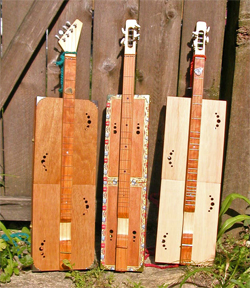 If you are looking to expand your cigar box instrument-building repertoire beyond the basic 3 and 4-string cigar box guitars, then consider taking a look at a classic instrument of American folk and roots music: the mountain dulcimer. A unique strummed/plucked instrument that is distinct from the hammered dulcimer, the mountain dulcimer is well suited to building with cigar boxes. In this article, experienced cigar box mountain dulcimer (CBMD) builder Diane from Chicago shares photos and discusses some of her methods for creating these beautiful instruments.
If you are looking to expand your cigar box instrument-building repertoire beyond the basic 3 and 4-string cigar box guitars, then consider taking a look at a classic instrument of American folk and roots music: the mountain dulcimer. A unique strummed/plucked instrument that is distinct from the hammered dulcimer, the mountain dulcimer is well suited to building with cigar boxes. In this article, experienced cigar box mountain dulcimer (CBMD) builder Diane from Chicago shares photos and discusses some of her methods for creating these beautiful instruments.
A mountain dulcimer is a 3 or 4-string instrument designed to be played in your lap. Most mountain dulcimers have diatonic fretting, so they only play the “do-re-mi” notes, leaving out the sharps and flats. This makes them very appealing for beginners and seasoned players alike. Playing a mountain dulcimer is fairly straightforward – the left hand fingers the notes on the frets and the right hand strums or picks the strings. Some people use a short hardwood stick, or “noter”, in the left hand to depress the strings to the frets, and fret only one string at a time, letting the other strings drone along with the melody. So there are many different ways to play this instrument – from simple to pleasantly complex.
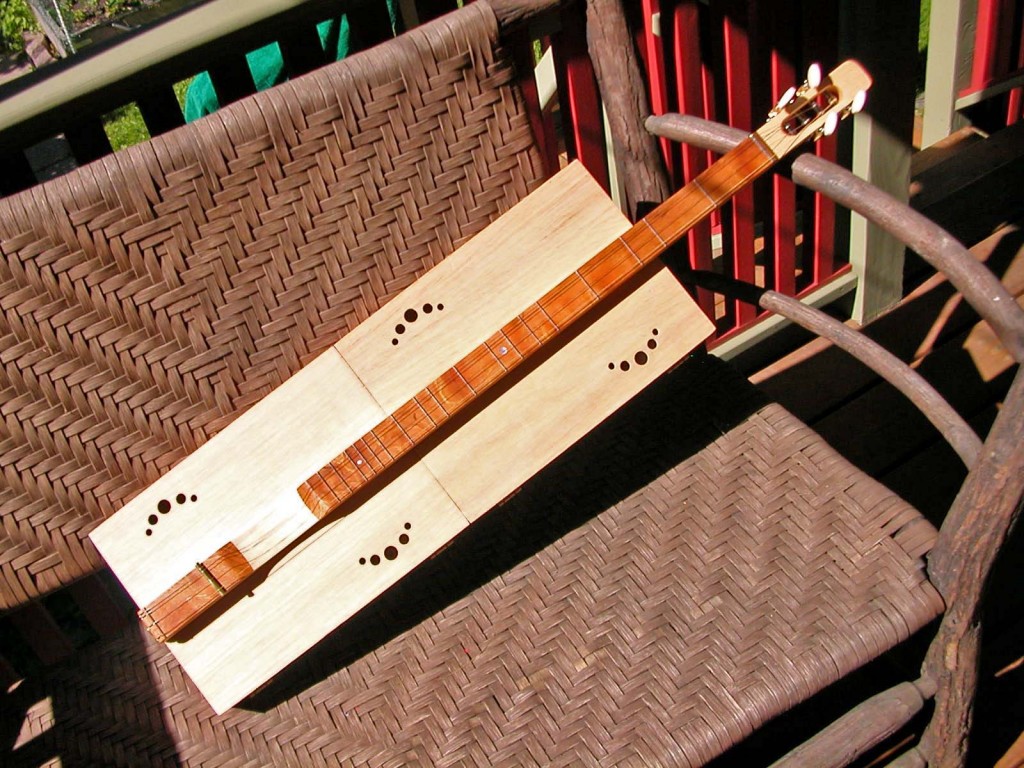
The soundbox of a mountain dulcimer can conceivably be any shape, though most modern luthiers make teardrop or hourglass design. Others have been built from long rectangular or coffin-shaped boxes. This oblong box shape lends itself well to using cigar boxes, as they can easily be made from two or three cigar boxes butted together end-to-end. You’ll want to choose deeper boxes for the best volume. I’ve used Don Pepin Garcias and Las Cabrillas boxes with great success, but it might take a bit of searching to find matched sets (two identical boxes).I craft my cigar box mountain dulcimer soundboxes by bolting the cigar boxes together through the inside. (I added a squirt of glue first to the outside surfaces, for extra measure). Because they tend to be thinner than the tops, I use the bottoms of the boxes as the playing surface, so I take special care to be sure they are flush to each other.
Even two of the “exact” same boxes are sometimes a fraction of an inch different. Note that if the sides of the cigar boxes you are joining together are paper-covered, you might want to remove the paper to get a better join with the glue.
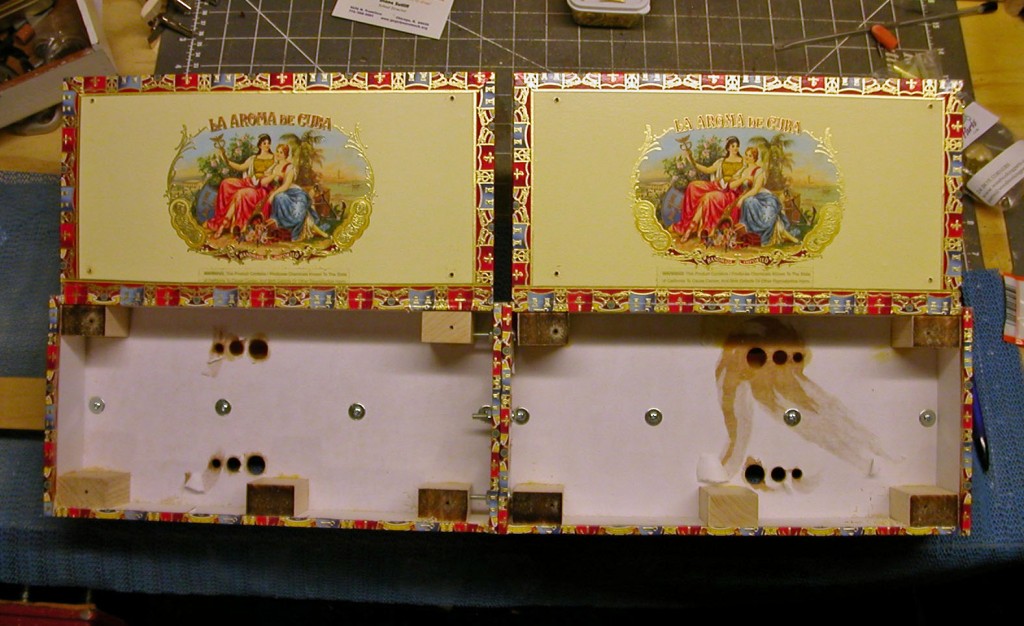
The fingerboard of a mountain dulcimer runs the entire length of the body and rests on the top of the instrument. Frets are installed for about two octaves, and builders often carve or sand out a strum hollow further down the fingerboard to give a bit more playing room. All that wood laying along your soundboard top can dampen the volume, so many builders sand out hollows on the underside the fingerboard as well so itonly makes contact with the soundbox at certain points (see photos for examples). An alternate method is to cut 1/8” thick rectangular risers and place them under the fingerboard at your chosen contact points so it floats above the soundboard.
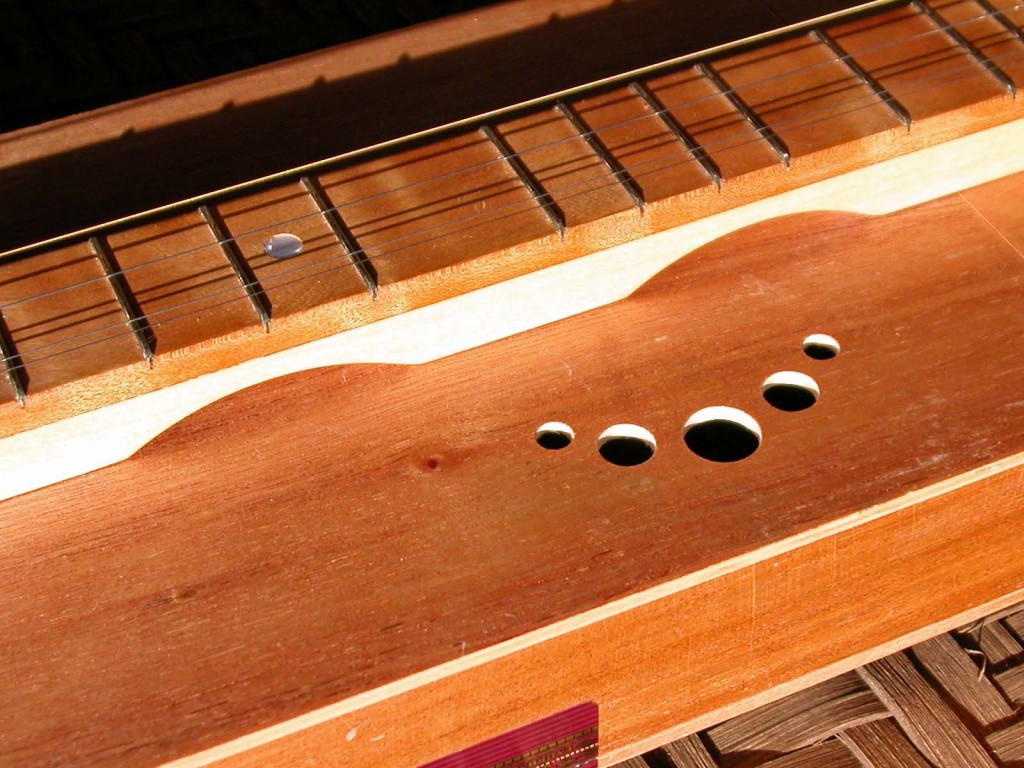
I use wood screws to attach my fingerboard to the soundboard, installed with washers from the underside. If your boxes do not latch firmly closed, they can be held closed by woodscrews into glued-in corner supports. A tightly sealed soundbox makes for a louder instrument with better tone.
Any style of headstock will work: slotted with side-mounted tuners , cutaway, or scarf join. Just be sure you get enough break angle over thenut or zero fret. Any kind of string termination you’d use on a cigar box guitar will work here, too: through the lid (if your boxes still open and close), through the tail, or tail-seated, like the one in the photo with the sliced brass tubing.
I like to have a floating bridge (ie, a bridge that can be moved instead of permanently affixed to the soundboard), and you can cut one from a scrap of wood or use a brass bar. The bar must be ground off to make a flat side, and notched on the top to make a very fine slot in which the strings can rest. The tension of the strings keeps them in place with only a bit of help from the slot. You can adjust the position of your floating bridge to give you accurate octave tunings at both the first and second octaves – something you don’t have to worry so much about on a cigar box guitar but is pretty important here.
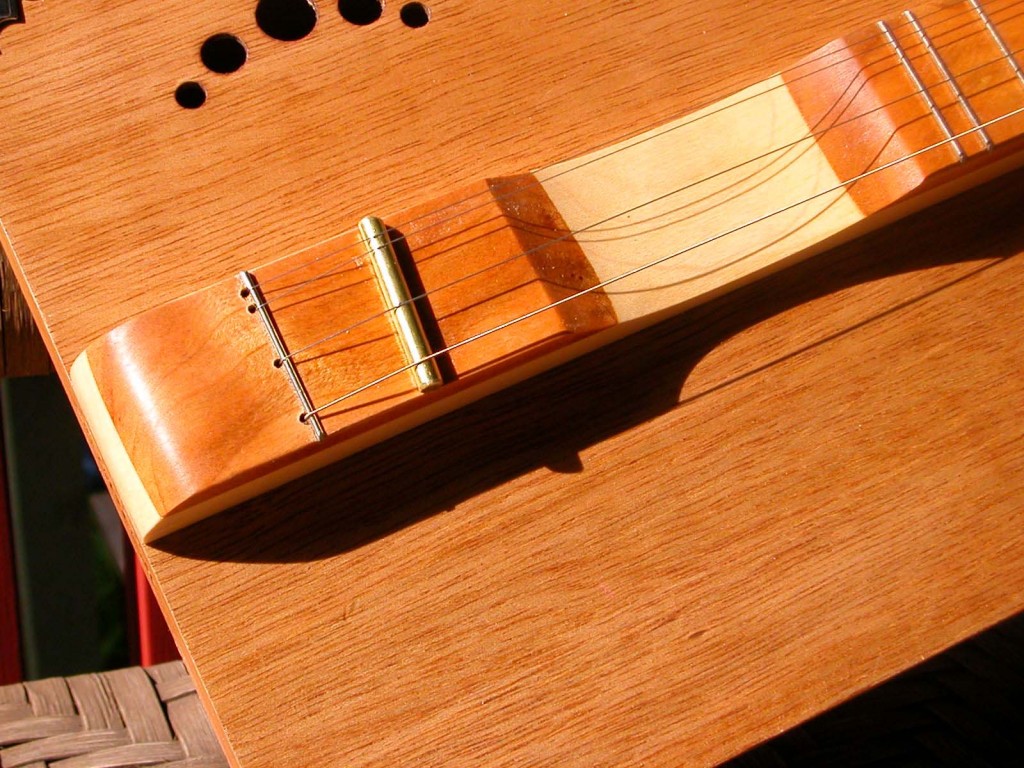
Most standard mountain dulcimers have a vibrating string length (VSL) of between 25” and 29”. I have smaller hands, so I made mine 24”. Generally dulcimers are tuned “DAd” (see below for an explanation of this notation method). I used string gauges .022″ bronze-wound, .014″ plain steel and .010″ plain steel, the same as C. B. Gitty’s Extra Light 3-string Acoustic Strings set . Remember that since this instrument is played in your lap, the strings are reversed so that the thinnest string is near your body and the heaviest string farthest away. Most of my mountain dulcimers have had two paired melody strings to give them bit of extra volume. Thus I build a 4-string headstock and plan for a 4-string tailpiece, but the instrument is played the same as a 3-string. The tuning is “DAdd”, with the two “dd” melody strings being played as
if they were a single string.
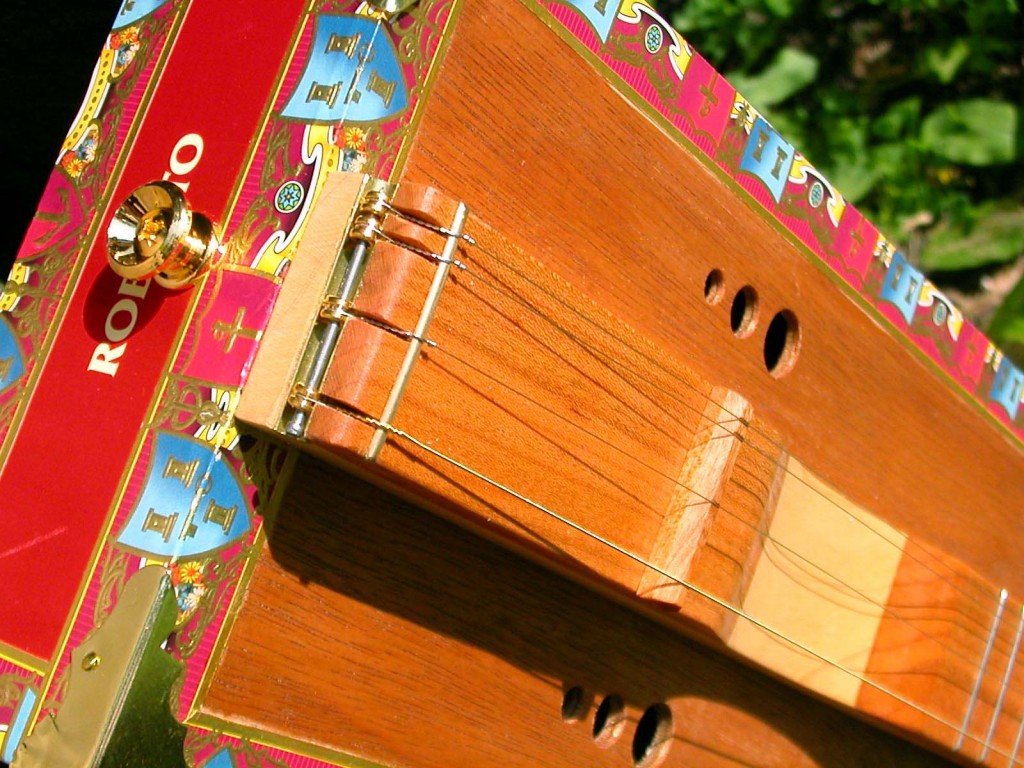
Because of the diatonic fretting, there are all sorts of alternate tunings you can use – with these very same strings! “DAc” will let you play songs in D minor, for example. “DGd” will give you the key of G major, and “DGc” for G minor. So one simple instrument allows for lots of different musical flavors.
How to read string tuning notation: When describing tuning on musical instruments, capital letters are the octave below and including middle C, and lowercase letters are the octave above middle C. So “D” would be the same as the #3 “D” string on a guitar, “e” would be the same as the high E string on a guitar, and “E” would be the low E string on a guitar, etc.
You can learn more about playing a mountain dulcimer here:
-
http://mountaindulcimer.ning.com/ – a helpful learning community
-
http://dulcimer-noter-drone.blogspot.com/ – an excellent blog for beginning players, with clear instructions on alternate tunings
-
http://everythingdulcimer.com/ – forum, resources, tabs, tunings, videos, photos and more!
-
http://dpnews.com/ – Dulcimer Player News magazine, and every issue comes with a CD of tunes on mountain and hammered dulcimers.
Diane lives, works and builds instruments in Chicago, Illinois, USA, and her cigar box instruments have been featured in a prominent Chicago-area weekly newspaper.

I have played dulcimers for many years and built about 6. I have recently become interested in CBG’s and want to build a cigar box dulcimer. This article is fascinating to me and I honor the author. Thanks again for a very interesting read and tutorial.
You’re never too old to start playing Steve!
The great thing about dulcimers is the ability to play without worrying about hitting a wrong note. Give it a try! I think you’ll be pleasantly surprised.
Great site. I have only discovered dulcimers in the last few weeks. As a keen amateur woodworker I’m looking into making my own. I think I may be a bit old to start playing but I’m willing to give it a go. BTW I’m from the UK, but now live in Portugal, so the only place I can hear a dulcimer is online.
I’ve made 2 mountain dulcimers so far, from scrap birch ply, and my next (almost finished) project is a dulcitar strum stick, also from scrap birch and a neck leg made from a portable barbecue leg. Scale length will be 25 1/2 inches, based on a long neck Greek bouzouki. It will have a floating bridge and already has a simple disc piezo pick up installed.
We’ll try to get to it Greg!
I really enjoyed this article and it has me interested in building my first dulcimer. Just a question…would it be possible to post a tutorial on how to make the tail seated string termination with the sliced brass tubing? Would love an explanation of that.
Thanks for all your help.